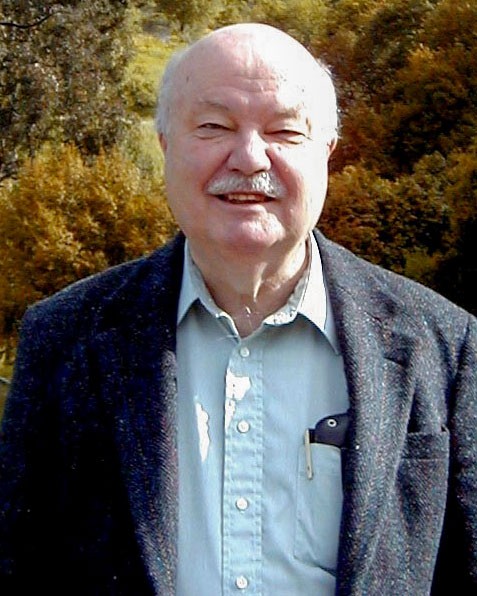Louis Hand, pioneer of high-energy physics, dies at 90
By Kate Blackwood
Louis Hand, professor emeritus of physics, died Oct. 30. He was 90.
An experimental physicist, Hand entered the field of high-energy physics during an era of great innovation in the 1950s and 1960s. He dedicated more than 40 years to the Cornell community as a professor in the Department of Physics in the College of Arts and Sciences (A&S) while traveling the world to collaborate with leading researchers at cutting-edge accelerator and collider laboratories. He initiated major discoveries and contributed to many more, his colleagues said.
“Since his pioneering graduate work on the production of elementary particles created in the interaction of high-energy electrons with protons, Lou was recognized internationally as an expert in the field,” said David Cassel, professor emeritus of physics (A&S). “He had broad interests and original insights in many areas of high-energy physics and accelerator physics. He pursued these interests with collaborators from Cornell and other national and international institutions.”
Colleagues remember Hand as a scientist devoted to discovery, both in his field of expertise and beyond.
“Here is the mark of a man truly dedicated to knowing more of this world,” said Nobel laureate Roald Hoffmann, the Frank H.T. Rhodes Professor Emeritus in the Department of Chemistry and Chemical Biology (A&S).
“When Lou Hand retired from the good experimental physics he had been doing for decades, he joined the small collective Neil Ashcroft [the late Horace White Professor of Physics Emeritus (A&S)] and I spontaneously formed to look at structures and properties of matter under high pressure – so different from what he had been so proficient in!” Hoffmann said. “Lou was thrown into the position of a graduate student, learning solid-state computations, even learning some chemistry. Lou did this with great patience, skill and, importantly, with good cheer. I remember the sparkle he had at our group meetings.”
Louis Hand was born in Hollywood, California, in 1933. Partway through his high school education, his family moved to New Jersey, where he graduated from the Lawrenceville School in 1951. A mathematics major and physics minor at Swarthmore College, he graduated in 1955.
As a doctoral student in experimental physics at Stanford University advised by noted physicist W.K.H. “Pief” Panofsky, Hand made significant contributions, alongside renowned Stanford scientists, to the modern experimental confirmation of Relativistic Form Factor description of both elastic and inelastic electron scattering, said Richard Talman, professor emeritus of physics (A&S).
Talman said that Hand worked on this breakthrough during a time of upheaval in the Stanford physics department, associated with introducing “big science” in the form of a national lab, SLAC, to the Stanford campus, which was “hardly ideal for a young graduate student,” Talman said. “Then and subsequently, Lou was familiar with great turmoil leading to great scientific advances.”
After receiving his Ph.D. from Stanford in 1961, Hand joined the physics department at Harvard University, also working on experiments for the Cambridge Electron Accelerator. He was an Alfred P. Sloan Fellow 1964-66.
In 1965 Hand conceived of and, with others, performed the first pion-produced muon pair experiment at the Alternating Gradient Synchrotron at Brookhaven National Laboratory, which foreshadowed the discovery in 1974 of the subatomic J/psi particle. This particle shed new light on quarks and their interactions.
The same year, Hand moved with his growing family to Cornell, starting as a tenured associate professor. He was promoted to professor in 1971.
At Cornell, Hand did research in experimental high-energy physics, both at the 2.2-GeV Electron Synchrotron in Newman Laboratory and the 10-GeV Synchrotron in Wilson Laboratory.
In 1970, he proposed an experimental search at Fermi National Accelerator Laboratory (Fermilab) for possible Bjorken scale invariance violations in the deep inelastic scattering of muons. This led to the discovery of scaling violations, which provided evidence for an important property of quantum field theories known as asymptotic freedom. He continued to work on other experiments at Fermilab, funded by the National Science Foundation (NSF), while also teaching at Cornell.
Hand’s work took him to major research centers in Europe. In 1980-81, a Guggenheim Fellowship in conjunction with a fellowship from Oxford University brought him to England.
NSF supported his work between 1982 and 1989 at the DESY electron-proton collider in Germany, where he spent several months of each year doing computer simulations and theoretical calculations for polarized electron beams. And in 1989, Hand spent four months on the staff at CERN in Geneva, Switzerland, working in the control room of the LEP accelerator, which was being commissioned at the time.
During the 1990s, Hand continued long-term theoretical research collaborations on a way to polarize electrons or positrons for a linear collider. Additional research ranged from polarizing electrons to niobium film to the search for new high temperature superconductors.
Hand was a member of the Cornell Center for Materials Research starting in 1998. He retired from Cornell in 2008, continuing research into high temperature superconductors.
Another of Hand’s legacies is “Analytical Mechanics,” a textbook he co-wrote in 1998 with colleague Janet (Finch) Scheel, Ph.D. ’00. A junior-level classical mechanics text, the book is still in print and in wide use. Innovative in its day, the text was designed to facilitate collaborative problem-solving between instructors and students using a brand-new technology: email.
Hand was preceded in death by his wife, Betsy, and their son, Jonathan. He is survived by his younger sister, Susan, and by three daughters and five grandchildren.
Media Contact
Get Cornell news delivered right to your inbox.
Subscribe

